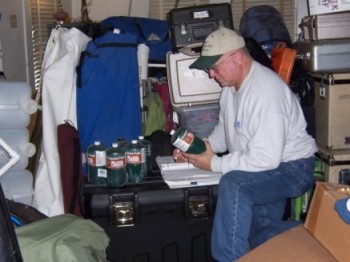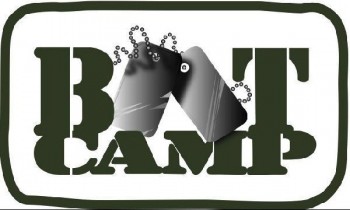 My son David KD5MTJ and myself made the trip up north to Austin to help out Paul KA5FZU with coordinating the ham radio communications for this year’s single day event. It started & ended at the Travis County Expo Center, east of Austin, and featured multiple routes (11, 30, 55, 78, 100) spread across two counties. Law enforcement support was great, especially the Williamson County Sheriff’s department who kept in close phone contact with me during the event until all riders had cleared out of his county. One rider, who was spotted by the WC Sheriff deputy appearing to be in health distress, was placed inside his patrol car for the air conditioning until we could send a SAG truck (ABC Home & Commercial Services) up to retrieve him. Talk about service? Don’t know if the rider was in the front or back seat, however. 🙂
My son David KD5MTJ and myself made the trip up north to Austin to help out Paul KA5FZU with coordinating the ham radio communications for this year’s single day event. It started & ended at the Travis County Expo Center, east of Austin, and featured multiple routes (11, 30, 55, 78, 100) spread across two counties. Law enforcement support was great, especially the Williamson County Sheriff’s department who kept in close phone contact with me during the event until all riders had cleared out of his county. One rider, who was spotted by the WC Sheriff deputy appearing to be in health distress, was placed inside his patrol car for the air conditioning until we could send a SAG truck (ABC Home & Commercial Services) up to retrieve him. Talk about service? Don’t know if the rider was in the front or back seat, however. 🙂
We used APRS trackers from the Austin Amateur Radio Club to track 6 of the SAG trucks and 6 of the supply trucks (Austin Energy). We coordinated medical coverage with the MSET-TX motorcycle group out of Austin, who provided a handful of trained, certified EMT motorcycle riders, able to respond promptly to medical incidents out on the route.
The Comm Center was setup inside the main Banquet Hall, in a small room that had no windows, and virtually zero air conditioning. We ran the coax cables up thru the false ceiling into a nearby electrical room, and then out thru an opening in the concrete block wall to our antennas. Internet services were provided by WiMaxSATX.com using CLEAR’s 4G WiMax Internet services.
Here are some photos taken during the event. As I get more time, I’ll add some captions to better explain them.
Read the rest of this entry »

 My son David KD5MTJ and myself made the trip up north to Austin to help out Paul KA5FZU with coordinating the ham radio communications for this year’s single day event. It started & ended at the Travis County Expo Center, east of Austin, and featured multiple routes (11, 30, 55, 78, 100) spread across two counties. Law enforcement support was great, especially the Williamson County Sheriff’s department who kept in close phone contact with me during the event until all riders had cleared out of his county. One rider, who was spotted by the WC Sheriff deputy appearing to be in health distress, was placed inside his patrol car for the air conditioning until we could send a SAG truck (ABC Home & Commercial Services) up to retrieve him. Talk about service? Don’t know if the rider was in the front or back seat, however. 🙂
My son David KD5MTJ and myself made the trip up north to Austin to help out Paul KA5FZU with coordinating the ham radio communications for this year’s single day event. It started & ended at the Travis County Expo Center, east of Austin, and featured multiple routes (11, 30, 55, 78, 100) spread across two counties. Law enforcement support was great, especially the Williamson County Sheriff’s department who kept in close phone contact with me during the event until all riders had cleared out of his county. One rider, who was spotted by the WC Sheriff deputy appearing to be in health distress, was placed inside his patrol car for the air conditioning until we could send a SAG truck (ABC Home & Commercial Services) up to retrieve him. Talk about service? Don’t know if the rider was in the front or back seat, however. 🙂
